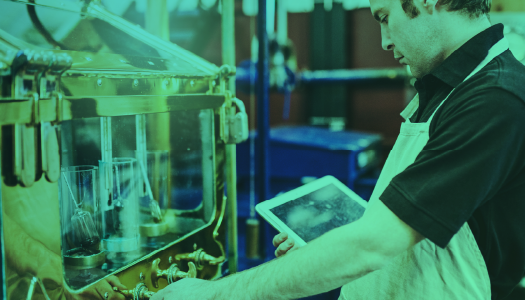Baby Formula Supply Chain Crisis—How a CMMS Could Have Helped
The 2022 baby formula shortage was a true crisis for many in the US. Beyond the heartbreaking illnesses, the stories of the stress and work it took for parents to locate the essential formula for their young babies—often driving many hours for a few cans of formula and paying exorbitant prices. A scary and troubling situation for all.
The events leading up to the shortage are numerous. Early COVID-19-influenced supply chain issues caused initial shortages. Later in the pandemic when the shortages ramped up, restrictions prevented alternative sources for US markets. The shortage culminated with the closure of a single manufacturing plant, responsible for producing 40% of baby formula sold in the country. Poor sanitary and operational conditions led to bacterial growth, forcing the plant to halt production.
Rewinding the Clock…
Rather than focus on the tragedy, let’s rewind the clock and learn how relatively small changes, including the use of technology, such as IoT sensors and a computerized maintenance management system (CMMS), combined with proven operational best practices could have minimized, and likely completely averted, this tragedy.
In maintenance and related operations, catching problems when they are small are easier to address, far less disruptive to operations and much less expensive to remedy. A CMMS has many benefits and features to support maintenance operations professionals:
- Facility and asset management
- Spare parts inventory control
- Work orders management
- Analytics and more
At the heart of CMMS is the easy ability to perform routine preventive maintenance (PM). Everyone knows, or should know, the value of preventive maintenance over waiting for disruptive, reactive maintenance. Benjamin Franklin famously said, “An ounce of prevention is worth a pound of cure.” If an organization is culturally dedicated to PM, it becomes very difficult to spiral out of control.
A common response is “we don’t have time for PM”. I agree, it is a challenging environment to keep and attract maintenance operations talent, stretching the abilities of the current teams. Still, an investment in your PM program far outweighs the operational, safety and financial problems that arise without. The baby formula tragedy is an extreme case of this. Moving to a PM culture does not have to be all-or-nothing. The SMRP (Society of Maintenance and Reliability Professionals) calls for an 80% PM/20% reactive maintenance ratio to be considered “stable” and 90%/10% split to be world-class. Most manufacturers I interact with are not at these ratios. The ones who are what I like to refer to as “the enlightened ones”—their operations run as smooth as possible, and their job is easier than their peers. They smile more than most maintenance professionals!
If you can’t be at an 80/20 ratio right away, start with an attainable goal—any incremental improvement can help. A good CMMS will help you set a key performance indicator (KPI) where you specify what you want to achieve and will show you in real time how you are doing. More PMs will eventually, often quickly, free up more time as you start to avoid those more disruptive events that lead to downtime. This has a positive snowball effect, allowing for more PMs, moving you closer to those better preventive and reactive ratios.
Just getting a reminder on a calendar basis (daily, weekly, monthly, etc.) to perform basic inspections and routine basic maintenance is helpful. A good CMMS will allow you to easily set these reminders up and include basic inspection or maintenance instructions. Your maintenance tech will receive automatic reminders and can easily perform PM tasks with the help of a mobile device. I will often suggest you start with a small, but important, list of assets, production lines or facility inspections. You can grow from there.
A CMMS can help bridge the gap between your more veteran (and often soon-to-be-retiring) and younger maintenance teammates. Basic instructions, pictures and even videos of these very-seasoned professionals are an awesome resource to help train and enable the next generation of techs. Starting the process of storing and passing down institutional knowledge via a CMMS can prevent gaps down the road.
Condition-Based Maintenance
Condition-Based Monitoring (CBM), especially added with IoT-type sensors can help catch problems much earlier, allowing for a quicker remedy and avoid the worst-case scenarios. Pairing IoT sensors with a world-class CMMS like Asset Essentials would have alerted the baby formula plant to standing water and allowed them to remedy it before being forced to stop production and close its doors.
CBM uses sensors that can be attached to assets, production lines and peppered throughout facilities. If a pump is vibrating outside of tolerance, the sensor can automatically create a work order, sending a notification to maintenance and streamlining your response. A “water leak rope sensor” can be placed in water-collection prone areas so that at the first sign of intrusion, you create a work order and get it fixed.
There are many types of sensors that can be retrofit onto assets. This moves an organization closer to a predictive maintenance environment, a step up from standard PM. It has never been easier, or as inexpensive, to utilize IoT as now. Doing so is all in the name of catching problems earlier when they are easier to remedy, less disruptive to operations and far less expensive.
It’s not just technology
There are numerous best practices that optimize operations. You can read up on many of them, such as 6-Sigma, Total Productive Maintenance and others. To me, a wonderful and easy to implement best-practice that would have helped prevent the baby formula crisis is Gemba Walks. At a high-level, a Gemba Walk is a “lean” operational best-practice that has a manager literally walk around their facility periodically and spend time where the “real work” (i.e., “Gemba” in Japanese) happens. The goal is to view and observe how operations are going with an eye on eventually making improvements, not on-the-spot. This brings that manager closer to their teams and operations. The manager can observe the entire value-stream, talking with plant floor operators, listening to their challenges and soaking in the operations.
Gemba Walks are not about quick-fixing obvious issues or laying any blame. It is a process that when done correctly can lead to operational improvements. A CMMS will absorb these improvements, typically with better PM inspections and related. This can truly help operations at any level or scale.
Conclusion
It is easy for us to look back on the events that led up to the baby formula supply chain crisis and pinpoint the places where it could have been avoided after the fact. For most manufacturers, we are not making the news for poor maintenance practices. For those that embrace a CMMS, smart technology like IoT sensors and best practices that build a preventive (and even predictive) maintenance culture will have smoother, safer and more profitable operations.




